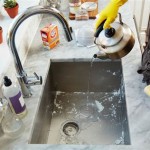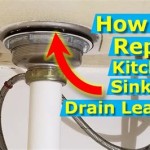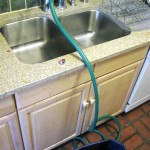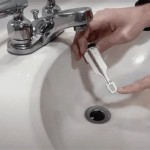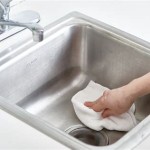How To Fix a Leaking Sink Handle
A leaking sink handle is a common household plumbing problem that can lead to wasted water, increased water bills, and potential damage to surrounding surfaces. Addressing this issue promptly is crucial to prevent further complications and maintain the integrity of your plumbing system. The process of fixing a leaking sink handle can vary depending on the type of faucet and the underlying cause of the leak. This article provides a comprehensive guide to diagnosing and resolving common causes of sink handle leaks.
Before embarking on any plumbing repair, it is necessary to prioritize safety. Always turn off the water supply to the sink before beginning any work. This usually involves locating the shut-off valves under the sink. Turn both the hot and cold water valves clockwise until they are completely closed. If the shut-off valves are corroded or malfunctioning, it might be necessary to shut off the main water supply to the house. It is also advisable to wear safety glasses to protect your eyes from debris and to have a well-lit workspace.
Once the water supply has been shut off, prepare the work area. Place a bucket under the sink to catch any residual water that may drip out during the repair process. Protect the sink basin with a towel or drop cloth to prevent scratches or damage from dropped tools. Gather the necessary tools, which may include a screwdriver set (both flathead and Phillips head), an adjustable wrench, a basin wrench (if needed), pliers, penetrating oil, replacement parts (O-rings, cartridges, or valve seats), and plumber's grease.
Identifying the Type of Faucet
Different types of faucets utilize various mechanisms to control water flow and temperature. Identifying the type of faucet is critical for determining the appropriate repair procedure. The most common types of faucets include compression faucets, cartridge faucets, ball faucets, and ceramic disc faucets.
Compression faucets are the oldest and simplest type of faucet. They typically have two separate handles, one for hot water and one for cold water. Each handle operates a valve that uses a rubber washer to seal against a valve seat. When the handle is turned on, the washer is lifted off the valve seat, allowing water to flow. Leaks in compression faucets are often caused by worn or damaged washers or corroded valve seats.
Cartridge faucets use a cylindrical cartridge to control water flow and temperature. These faucets usually have a single handle that moves up and down to control water flow and left to right to adjust the temperature. The cartridge contains internal seals and passages that regulate the mixing of hot and cold water. Leaks in cartridge faucets are often caused by worn or damaged O-rings or a faulty cartridge.
Ball faucets are characterized by a single handle that pivots on a ball joint. The ball contains slots and chambers that control the mixing of hot and cold water. These faucets have a more complex design than compression or cartridge faucets and contain several components, including O-rings, springs, and a cam assembly. Leaks in ball faucets are often caused by worn or damaged O-rings, springs, or seats.
Ceramic disc faucets are the most modern and durable type of faucet. They use two ceramic discs that slide against each other to control water flow. These faucets typically have a single lever that moves up and down for water flow and left to right for temperature. Ceramic disc faucets are less prone to leaks than other types of faucets due to the hard and durable nature of the ceramic discs. However, leaks can still occur due to damaged discs or seals.
Diagnosing the Cause of the Leak
Once the faucet type has been identified, the next step is to diagnose the cause of the leak. Observe the faucet closely to determine where the water is leaking from. Common leak locations include around the base of the handle, from the spout, or from underneath the sink.
If the leak is coming from around the base of the handle, it is likely due to worn or damaged O-rings. O-rings are small rubber seals that prevent water from escaping around the faucet stem or cartridge. Over time, O-rings can become brittle and cracked, leading to leaks. In compression faucets, the packing nut, which holds the stem in place, may also be loose, causing leaks around the handle. Tightening the packing nut may temporarily stop the leak, but replacing the O-rings is the most reliable solution.
If the leak is coming from the spout, the problem is likely related to the valve seat or internal seals within the faucet. In compression faucets, a worn or damaged washer or a corroded valve seat can cause water to drip from the spout. In cartridge, ball, and ceramic disc faucets, leaks from the spout can be caused by a faulty cartridge, worn O-rings, or damaged ceramic discs.
Leaks underneath the sink are often caused by loose connections, corroded pipes, or damaged supply lines. Carefully inspect the pipes and connections for signs of leaks. Tighten any loose connections with an adjustable wrench. If the pipes are corroded or damaged, they may need to be replaced. Check the supply lines that connect the faucet to the shut-off valves. If the supply lines are cracked or leaking, they should be replaced immediately.
Repairing the Leaking Sink Handle
The repair procedure will vary depending on the type of faucet and the cause of the leak. The following sections provide general guidelines for repairing common types of faucet leaks.
Repairing a Compression Faucet Leak:
1. Turn off the water supply to the sink.
2. Remove the handle screw, which is usually located under a decorative cap on top of the handle. Use a screwdriver to remove the handle screw and then pull the handle off the faucet stem.
3. Use an adjustable wrench to loosen and remove the packing nut, which is located around the stem. Be careful not to damage the stem or the surrounding finish.
4. Remove the stem from the faucet body. You may need to use pliers to grip the stem and gently pull it out.
5. Inspect the rubber washer at the bottom of the stem. If the washer is worn, cracked, or damaged, replace it with a new washer of the same size and shape.
6. Inspect the valve seat inside the faucet body. If the valve seat is corroded or damaged, use a valve seat wrench to remove and replace it. If a valve seat wrench is not available, you can try cleaning the valve seat with a specialized valve seat dressing tool.
7. Apply plumber's grease to the new washer and valve seat to ensure a good seal.
8. Reassemble the faucet in the reverse order of disassembly. Tighten the packing nut securely, but do not overtighten it.
9. Turn on the water supply and check for leaks. If the leak persists, tighten the packing nut slightly more.
Repairing a Cartridge Faucet Leak:
1. Turn off the water supply to the sink.
2. Remove the handle screw, which is usually located under a decorative cap on the side of the handle. Use a screwdriver to remove the handle screw and then pull the handle off the faucet body.
3. Depending on the faucet model, there may be a retaining clip or nut that holds the cartridge in place. Remove the retaining clip or nut with pliers or an adjustable wrench.
4. Pull the cartridge straight up out of the faucet body. You may need to use pliers to grip the cartridge and gently wiggle it out.
5. Inspect the O-rings on the cartridge. If the O-rings are worn, cracked, or damaged, replace them with new O-rings of the same size and shape. Apply plumber's grease to the new O-rings before installing them on the cartridge.
6. Inspect the cartridge itself for any signs of damage. If the cartridge is cracked or broken, it should be replaced with a new cartridge.
7. Reinstall the cartridge into the faucet body, making sure it is properly aligned.
8. Reinstall the retaining clip or nut to secure the cartridge in place.
9. Reattach the handle and tighten the handle screw.
10. Turn on the water supply and check for leaks. If the leak persists, the cartridge may need to be replaced.
Repairing a Ball Faucet Leak:
1. Turn off the water supply to the sink.
2. Use a small Allen wrench to loosen the set screw on the side of the handle.
3. Lift the handle off the faucet body.
4. Use a wrench to loosen the cap and collar that hold the ball in place.
5. Remove the cap, collar, and ball from the faucet body.
6. Inspect the O-rings and springs located beneath the ball. These are the most common causes of leaks in ball faucets. Replace any worn or damaged O-rings and springs.
7. Inspect the ball for scratches or wear. If the ball is damaged, it should be replaced.
8. Reassemble the faucet in the reverse order of disassembly. Be sure to lubricate the O-rings with plumber's grease before installation.
9. Turn on the water supply and check for leaks.
Repairing a Ceramic Disc Faucet Leak:
1. Turn off the water supply to the sink.
2. Remove the handle screw, which is usually located under a decorative cap on the side of the handle.
3. Lift the handle off the faucet body.
4. Remove the escutcheon cap, which may be threaded or held in place with a set screw.
5. Loosen the cylinder lock nut and remove the ceramic disc cylinder.
6. Inspect the neoprene seals. Over time, these seals can become worn out and cause leaks. Replace any worn seals.
7. Reassemble the faucet in the reverse order of disassembly.
8. Turn on the water supply and check for leaks.
If the leak still persists after attempting these repairs, it may be necessary to replace the entire faucet. Faucet replacement is a more involved process and may require some plumbing experience. If you are not comfortable performing this task, it is best to consult with a qualified plumber.
Regular maintenance can help prevent faucet leaks and extend the life of your plumbing fixtures. Periodically inspect your faucets for signs of leaks or wear. Tighten any loose connections and replace worn O-rings or washers as needed. Avoid using abrasive cleaners or harsh chemicals on your faucets, as these can damage the finish and seals. By taking these steps, you can keep your faucets in good working order and prevent costly repairs in the future.
How To Fix A Leaking Faucet Handle Replacing Stem Assembly Youtube
How To Fix A Leaky Faucet The Home
How To Fix A Leaky Faucet Handle Beginner Friendly Guide
How To Fix A Leaky Faucet Guides For Every Design And Style
Repair A Leaky Faucet Denver Water
How To Fix A Leaking Faucet Handle Replacing Stem Assembly
How To Fix A Leaky Faucet Guides For Every Design And Style
How To Fix A Dripping Or Leaky Double Handle Faucet
How To Fix A Leaky Faucet The Home
How To Fix A Leaky Faucet Guides For Every Design And Style
